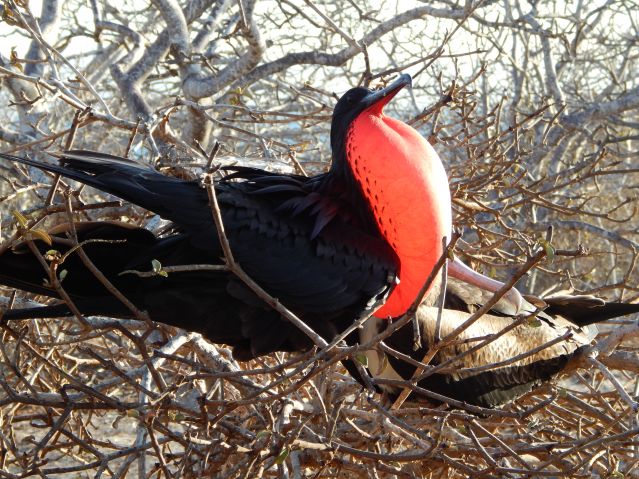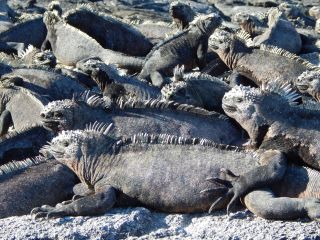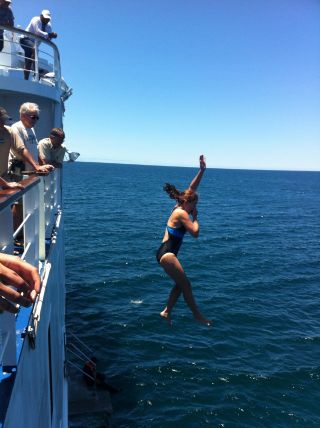Environment
Brain Change in the Galapagos
A trip to the Galapagos reveals an unexpected gift: a new perspective.
Posted October 25, 2013

Frigate courting on North Seymour
Nature astounds in the Galapagos from the red bulge of the courting male frigate, to the marine iguana mosh pits, to 300 pound sea lion bulls hurtling themselves through the air. I anticipated nature nirvana; the Galapagos delivered beyond expectation. Darwin’s perfect nature laboratory also provided an adaptation study I didn’t expect: the human brain.The passengers of La Pinta were mostly strangers from points in the world that harbor Charles Darwin geeks: United Kingdom, Australia, Canada, Germany, Ireland, Ecuador, and the USA. Of 27 passengers, about half were between the ages of 22-30 and the other half beween 50 and 82. The under-30 Backpack Crowd sported tans, sun-streaked hair and stories about which city in South America had the best meal under $2. They got the walk-up cruise discount. The rest of us, the over 50 Darwin Dreamers, paid full price to carve a week in our lives for a nature-loving-bucket-list-once-in-a-lifetime trip. The mix of people inspired conversations and actions impossible to imagine in a homogenous group.

Marine iguana mosh pit
In the US, people tend to socialize, study or work with people of approximately the same age. There's a collateral hazard inherent in this age segregation. Problems of that age group magnify. Toddler parents nail bite over potty training. Parents of teens agonize about whether or not their children will get into the right college. University students whip themselves into a frenzy around exam time, as any college counseling center can attest. My private solution to this issue is to reach out to people older and younger to recalibrate my perspective. The voyage of La Pinta provided the optimum playground for my much needed brain stretch.
I met Christine, a Brit who worried she might hold up the rest of the group, while filling my water bottle. “This trip is my 80th birthday present to myself,” she announced, unprompted. She gripped her folding cane chair with one hand and standard cane in the other. At 80 years old, Christine traveled alone, from London to Quito to Guayaquil to Baltra to catch a panga to a boat full of strangers. I later watched her wiggle into a wetsuit. She wobbled over the panga onto solid ground, but she did it. Does anyone look nimble exiting a panga? Despite the risk of an embarrassing slip, Christine chose action.

Christine and Dan conversing with a giant tortoise
Inaction breeds atrophy, adaptation spawns action. I watched Christine lean on others, a wall, a ledge and her cane for balance. She adapted and moved ahead. Another woman, Rainey, age 82, used two hiking sticks like a cross-country skier as she marched along the trail. Her legs looked strong, steady and determined. Slower than they once were? No doubt. But these women chose not to acquiesce to the pull of age; they pushed harder to maintain momentum. When most women their age consider a trip out of their cities a challenge, Christine and Rainey hop continents.
Not only the 80 year olds adapted. My good friend, Sara, casually mentioned she’d been trapped under a tarp in a pool as a four year-old. She almost drowned. "I'm a little panicky in the water," she confided, "but good thing you'll be there." Funny thing is, I'm a lousy swimmer. I flunked the swim test my freshman year at Notre Dame. In my 20s, I had a diving accident. Didn’t equalize the pressure in my mask. The white portion of my eyes turned blood-red for six weeks. I’m not the ideal person to cling to in a water emergency.
Together, we stretched our brains past our nervousness. We pulled on our wetsuits, jumped in the water and kicked our fins. Sea turtles, sea lions, a penguin surrounded by a living outline of millions of fish rewarded our efforts. We swam within arms reach, sometimes bumping each other in comfortable closeness. Our friendship proved the adaptation to open an underwater world.
Above ground a few days later, the Backpack Crowd gathered on the deck of La Pinta to jump into the ocean. The drop looked about 25 feet, into icy water. They leapt with screams, laughter and comic poses, with no worries about broken bones or pulled muscles. I watched passively, remembering younger days when I might have done the same. Suddenly, I found myself stripping down to my swimsuit and walking toward the deck. I ran through the list of things I might break when I hit the water: leg, back, neck. We began the count: one, two, three. I closed my eyes and leapt.

Me jumping off La Pinta
I emerged with a sore thigh and a soaring spirit. A jump like that is a silly thing, but defiant, not unlike hopping a continent in an eighth decade. I didn’t need to jump. Christine and Rainey didn’t need to go beyond the safe walls of their homes. Sara didn’t need to snorkel. But we did.
We adapted and chose motion. What did we gain?
Perspective. Humor. Lightness. A brain ready to tackle life post vacation with a new zest. Our brains adapted, influenced by a gaggle of strangers of all ages who felt like friends by the end of the trip.
One day, I hope a voyage of La Pinta, like the HMS Beagle, will inspire someone to measure what seems today immeasurable: the the impact of adaptation and perspective on brain health. Charles Darwin’s theory of evolution hatched from a tedious study of finch beaks. Perhaps in some laboratory, right now, some study of neurons is the finch beak equivalent of so many questions unanswered about the brain.
I hope so. Until then, I have a bruise on my thigh that has almost healed.
And a brain that feels alive.
For more information about Julie K. Hersh, go to her Struck by Living website.




